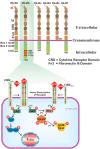Emergence of Leptin in Infection and Immunity: Scope and Challenges in Vaccines Formulation
- PMID: 29868503
- PMCID: PMC5954041
- DOI: 10.3389/fcimb.2018.00147
Emergence of Leptin in Infection and Immunity: Scope and Challenges in Vaccines Formulation
Abstract
Deficiency of leptin (ob/ob) and/or desensitization of leptin signaling (db/db) and elevated expression of suppressor of cytokine signaling-3 (SOCS3) reported in obesity are also reported in a variety of pathologies including hypertriglyceridemia, insulin resistance, and malnutrition as the risk factors in host defense system. Viral infections cause the elevated SOCS3 expression, which inhibits leptin signaling. It results in immunosuppression by T-regulatory cells (Tregs). The host immunity becomes incompetent to manage pathogens' attack and invasion, which results in the accelerated infections and diminished vaccine-specific antibody response. Leptin was successfully used as mucosal vaccine adjuvant against Rhodococcus equi. Leptin induced the antibody response to Helicobacter pylori vaccination in mice. An integral leptin signaling in mucosal gut epithelial cells offered resistance against Clostridium difficile and Entameoba histolytica infections. We present in this review, the intervention of leptin in lethal diseases caused by microbial infections and propose the possible scope and challenges of leptin as an adjuvant tool in the development of effective vaccines.
Keywords: immunity; infections; leptin; malnutrition; obesity; vaccination.
Figures


Similar articles
-
Mucosal co-immunization of mice with recombinant lactococci secreting VapA antigen and leptin elicits a protective immune response against Rhodococcus equi infection.Vaccine. 2011 Dec 9;30(1):95-102. doi: 10.1016/j.vaccine.2011.10.026. Epub 2011 Oct 20. Vaccine. 2011. PMID: 22019740
-
Role of leptin-mediated colonic inflammation in defense against Clostridium difficile colitis.Infect Immun. 2014 Jan;82(1):341-9. doi: 10.1128/IAI.00972-13. Epub 2013 Oct 28. Infect Immun. 2014. PMID: 24166957 Free PMC article.
-
Clostridium difficile flagellin FliC: Evaluation as adjuvant and use in a mucosal vaccine against Clostridium difficile.PLoS One. 2017 Nov 27;12(11):e0187212. doi: 10.1371/journal.pone.0187212. eCollection 2017. PLoS One. 2017. PMID: 29176760 Free PMC article.
-
Leptin-based adjuvants: an innovative approach to improve vaccine response.Vaccine. 2013 Mar 25;31(13):1666-72. doi: 10.1016/j.vaccine.2013.01.032. Epub 2013 Jan 29. Vaccine. 2013. PMID: 23370154 Free PMC article. Review.
-
Inflammation, immunity, vaccines for Helicobacter pylori infection.Helicobacter. 2013 Sep;18 Suppl 1:18-23. doi: 10.1111/hel.12073. Helicobacter. 2013. PMID: 24011240 Review.
Cited by
-
Bioinformatics insights into the genes and pathways on severe COVID-19 pathology in patients with comorbidities.Front Physiol. 2022 Dec 14;13:1045469. doi: 10.3389/fphys.2022.1045469. eCollection 2022. Front Physiol. 2022. PMID: 36589459 Free PMC article.
-
The Role of the Adipokine Leptin in Immune Cell Function in Health and Disease.Front Immunol. 2021 Jan 29;11:622468. doi: 10.3389/fimmu.2020.622468. eCollection 2020. Front Immunol. 2021. PMID: 33584724 Free PMC article. Review.
-
Chronic Leptin Deficiency Improves Tolerance of Physiological Damage and Host-Pathogen Cooperation during Yersinia pseudotuberculosis Infection.Infect Immun. 2022 Sep 15;90(9):e0024222. doi: 10.1128/iai.00242-22. Epub 2022 Aug 4. Infect Immun. 2022. PMID: 35924898 Free PMC article.
-
Impact of Obesity on Influenza A Virus Pathogenesis, Immune Response, and Evolution.Front Immunol. 2019 May 10;10:1071. doi: 10.3389/fimmu.2019.01071. eCollection 2019. Front Immunol. 2019. PMID: 31134099 Free PMC article. Review.
-
The effect of leptin gene polymorphisms (LEP rs7799039 and LEPR rs1137101) on febrile neutropenia.Heliyon. 2024 Mar 28;10(7):e28788. doi: 10.1016/j.heliyon.2024.e28788. eCollection 2024 Apr 15. Heliyon. 2024. PMID: 38586343 Free PMC article.
References
-
- Alam F., Salam A., Mahmood I., Kabir M., Chowdhury S. (2016). Amebic liver abscess is associated with malnutrition and low serum leptin level. J. Infect. Dis. Ther. 4:298 10.4172/2332-0877.1000298 - DOI
Publication types
MeSH terms
Substances
LinkOut - more resources
Full Text Sources
Other Literature Sources
Medical
Miscellaneous

